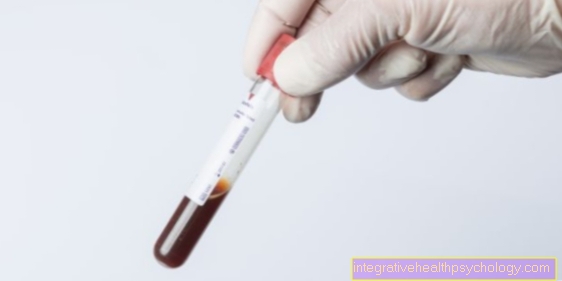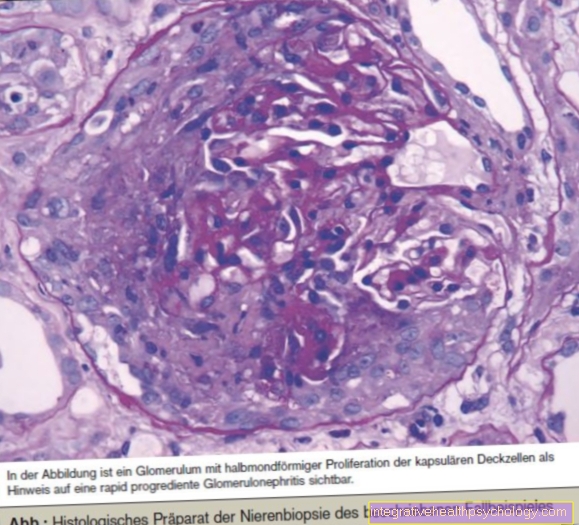Changes in blood values in cirrhosis of the liver
introduction
Liver cirrhosis is a highly complex clinical picture, which can be associated with numerous secondary diseases, symptoms and difficulties. Ultimately, all chronic diseases of the liver tissue without treatment or elimination of the causes lead to a remodeling of the liver cells and cirrhosis.
Over time, cirrhosis of the liver restricts all liver functions and is therefore a life-threatening and, if untreated, fatal clinical picture. In addition to the clear clinical signs and symptoms, the blood values can provide important clues for the presence and severity of liver cirrhosis and its secondary diseases.

Cirrhosis of the liver can be recognized by these blood values
Liver cirrhosis is a chronic and incurable disease that progresses over time and results in increasing impairment of liver function. The liver takes on filter functions that are essential for survival, but also the production of essential substances in the body.
A first indicator of the onset of damage to the liver tissue are the transaminases, colloquially known as "liver values". These are enzymes in the liver that enter the blood when cells are damaged and can be measured there. Furthermore, enzymes of the biliary tract can also be measured in the blood due to the liver damage, which also indicate non-specific liver diseases.
First of all, the liver can compensate for the restricted function so that no further symptoms or blood values are noticed. Only with cirrhosis of most of the liver do noticeable changes occur, which can be attributed to a restricted filter performance and a restricted production of the molecules produced in the liver.
The most important changes relevant to survival occur in the detoxification of substances such as ammonia, the coagulation function of the blood, protein production and the production of blood cells and platelets. These malfunctions can be diagnosed on the basis of the blood values and checked in the course.
Find out more about the different ones here Stages of cirrhosis of the liver.
The coagulation values
Blood coagulation is a vital and complex system made up of numerous cells, messenger substances, so-called "coagulation factors" and blood platelets. Liver function is very important to the maintenance of this functioning system.
If the blood clotting is restricted by the cirrhosis of the liver, severe, insatiable bleeding can occur. The additional formation of severe vascular changes in the course of liver cirrhosis can lead to life-threatening bleeding as an important complication. The liver function mainly influences the production of the coagulation factors. However, it can also lead to platelet disorders via an accompanying malfunction of the spleen and thus weaken blood clotting in two ways.
Typical blood values that measure the extent of the coagulation disorder are the so-called "Quick value" and the "INR value". The number of thrombocytes, the blood platelets, can also be recorded as a laboratory value. In emergency therapy for severe bleeding and advanced liver damage, the deficiencies can be treated symptomatically by transfusing blood platelets and blood plasma.
The symptoms of cirrhosis of the liver? Find out more about this topic here.
The liver values
The so-called liver values are an early diagnostic tool for liver damage of all kinds. The liver values are various substances and enzymes that are normally located within the liver cells or cells of the biliary tract and are only released when the tissue is damaged and increase in the blood are found.
However, an increase in these liver values does not mean that cirrhosis is present. Harmless liver damage can also cause abnormal liver values. Typical are repeated alcohol consumption, liver inflammation and fatty liver as the cause of the high liver values. However, these are basically curable clinical pictures.
At the same time, the liver values speak for acute damage to the liver cells. For example, the liver values can be in the normal range even with cirrhosis of the liver if the disease is not currently progressing and the disease activity is low.
Read more on the topic Liver values.
The bilirubin
Bilirubin is a breakdown product of hemoglobin, which is located in the red blood cells and is responsible for transporting oxygen in the blood. Bilirubin occurs in numerous metabolic processes and an increase in bilirubin can have a variety of causes.
The bilirubin that is produced when blood cells are broken down normally reaches the liver, where it goes through various metabolic processes and is then excreted with the bile into the intestine. If there is an extremely high breakdown of red blood cells, liver damage or biliary blockage between the liver and intestine, the bilirubin levels in the blood can increase. If the liver is damaged, large amounts of bilirubin can enter the blood and cause the typical jaundice of the eyes or skin. However, this is by no means a specific blood value, as numerous other causes can be behind the increase in bilirubin levels.
Learn more about the topic: The jaundice.
The albumin
Albumin is an important protein in the human body that, together with other proteins in the blood, performs numerous functions. One of its most important tasks is to maintain the so-called "colloid osmotic pressure" in the blood. It causes the solubility of certain poorly soluble substances and, through various processes in the blood, ensures that fluid remains within the vessels and does not pass into the surrounding tissue through the vessel walls.
The albumin is mainly produced in the liver with numerous other important proteins, which is why there is considerable albumin deficiency in advanced liver damage. As a result, water retention occurs in unusual places in the body, which can take on serious proportions. The formation of ascites as a result of the albumin deficiency is typical. Several liters of water can accumulate within the abdominal cavity and cause secondary symptoms.
Drop in platelets
The blood platelets, also called "thrombocytes" in technical terms, are an important form of cells in the blood count. Their most important function is the thrombocytes in the blood clotting process. They are responsible for the first phase of hemostasis through the adhesion of the cells with the first closure of the wound. A lack of platelets can consequently lead to heavy and insatiable bleeding.
However, a deficiency is often initially noticed by small punctiform hemorrhages under the skin, so-called "petechiae". Even if the platelets are produced in the bone marrow, they are dependent on the functioning of the liver.
Due to the increased function of the spleen in the context of liver cirrhosis, the platelets are increasingly broken down, which means that their blood levels decrease. This, too, is a typical but very unspecific symptom of liver cirrhosis, since low blood platelets can be traced back to numerous causes.
Also read the article: Therapy of cirrhosis of the liver.
Decrease in white blood cells
White blood cells are a number of cells in the blood that play a key role in the functioning of the immune system. The most important representatives are the granulocytes and the lymphocytes. With the help of a so-called “differential blood count” it can be further differentiated which of the white blood cells are relatively elevated or decreased, which allows further conclusions to be drawn about the cause.
In the context of liver cirrhosis, the deficiency of white blood cells is also caused by an overactive spleen. The hyperfunction occurs as a direct result of liver damage and causes various cells in the blood to break down. The progressive immune deficiency leads in the long term to a considerably increased susceptibility to bacterial, viral and all other infectious agents. This results in an enormous risk for cirrhotics to get a life-threatening infection.
Increase in ammonia levels
Many metabolic processes in the body produce nitrogen in the form of ammonia as a by-product. This is a poisonous substance that the body can normally break down and excrete in the liver via the so-called "urea cycle", a chain of chemical reactions. With advanced liver cirrhosis, these detoxification and filtration functions of the liver fail, which can lead to an accumulation of numerous other toxins in the body in addition to ammonia. The increased ammonia levels can also be detected in the blood.
A serious complication of cirrhosis of the liver is a sharp increase in ammonia with damage to brain structures. This damage can manifest as poor concentration, tremors, impaired consciousness and ultimately in a coma.
Also read the article: The diet in cirrhosis of the liver.
Can you have good blood counts despite cirrhosis of the liver?
Liver cirrhosis describes a chronic remodeling process of the liver tissue with a slow progressive loss of liver function. In the early stages of liver cirrhosis, numerous parts of the liver are often still functional and can easily compensate for the cirrhotic areas. The healthy parts of the liver can also grow as a result of the chronic damage, so that good liver functions are maintained for a long time.
Only when a large part of the liver function is lost do complaints and symptoms appear, which is referred to as “decompensation”. Up to this point, the blood values can also remain normal.
Find out more about the here different stages of liver cirrhosis.





























